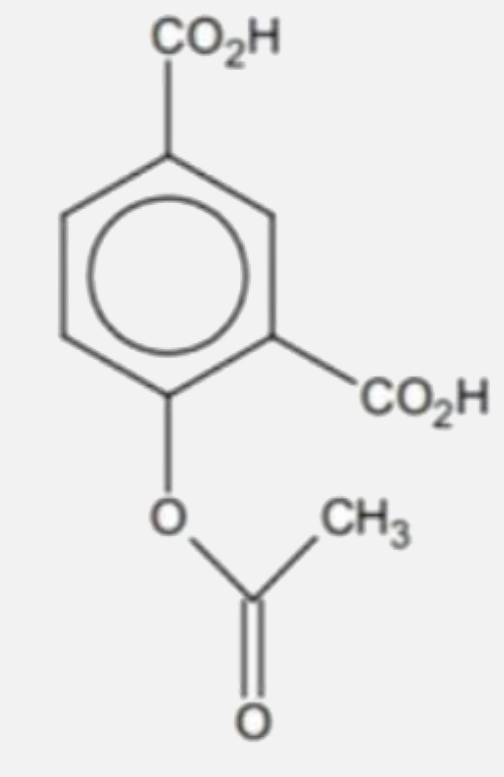Phenol on treatment with CO2 in the presence of NaOH followed by acidification produces compound X as the major product. X on treatment with (CH3CO)2O in the presence of catalytic amount of H2SO4 produces




The correct Answer is:B
To solve the problem step by step, we will analyze the reactions involved when phenol is treated with CO₂ in the presence of NaOH, followed by acidification, and then the reaction of the resulting compound with acetic anhydride in the presence of H₂SO₄.
Step 1: Reaction of Phenol with CO₂ and NaOH
1. Phenol (C₆H₅OH) reacts with NaOH to form the phenoxide ion (C₆H₅O⁻).
2. The phenoxide ion then reacts with CO₂ in a reaction known as the Kolbe's reaction. The negative charge on the oxygen attacks the carbon of CO₂, leading to the formation of a carboxylate ion.
3. The intermediate formed is then protonated upon acidification to yield salicylic acid (C₇H₆O₃), which has both a hydroxyl group (-OH) and a carboxylic acid group (-COOH) on the aromatic ring.
Step 2: Structure of Compound X
- The major product X formed from the reaction of phenol with CO₂ and NaOH, followed by acidification, is salicylic acid.
Step 3: Reaction of Salicylic Acid with Acetic Anhydride
1. Salicylic acid (C₇H₆O₃) is treated with acetic anhydride (C₄H₆O₃) in the presence of a catalytic amount of H₂SO₄.
2. The hydroxyl group (-OH) of salicylic acid attacks the carbonyl carbon of acetic anhydride, leading to the formation of an ester.
3. This reaction results in the formation of acetylsalicylic acid (C₉H₈O₄), commonly known as aspirin, where the -OH group of salicylic acid is converted into an -OCOCH₃ (acetyl) group.
Final Product
- The final product obtained from the reaction of salicylic acid with acetic anhydride is acetylsalicylic acid (aspirin).
Summary of the Steps
1. Phenol reacts with NaOH and CO₂ to form salicylic acid (X).
2. Salicylic acid reacts with acetic anhydride to form acetylsalicylic acid (aspirin).
1. Phenol (C₆H₅OH) reacts with NaOH to form the phenoxide ion (C₆H₅O⁻).
2. The phenoxide ion then reacts with CO₂ in a reaction known as the Kolbe's reaction. The negative charge on the oxygen attacks the carbon of CO₂, leading to the formation of a carboxylate ion.
3. The intermediate formed is then protonated upon acidification to yield salicylic acid (C₇H₆O₃), which has both a hydroxyl group (-OH) and a carboxylic acid group (-COOH) on the aromatic ring.
- The major product X formed from the reaction of phenol with CO₂ and NaOH, followed by acidification, is salicylic acid.
1. Salicylic acid (C₇H₆O₃) is treated with acetic anhydride (C₄H₆O₃) in the presence of a catalytic amount of H₂SO₄.
2. The hydroxyl group (-OH) of salicylic acid attacks the carbonyl carbon of acetic anhydride, leading to the formation of an ester.
3. This reaction results in the formation of acetylsalicylic acid (C₉H₈O₄), commonly known as aspirin, where the -OH group of salicylic acid is converted into an -OCOCH₃ (acetyl) group.
- The final product obtained from the reaction of salicylic acid with acetic anhydride is acetylsalicylic acid (aspirin).
1. Phenol reacts with NaOH and CO₂ to form salicylic acid (X).
2. Salicylic acid reacts with acetic anhydride to form acetylsalicylic acid (aspirin).
Similar Questions
Knowledge Check
Phenol reacts with conc. HNO3 in the presence of conc. H2SO4 to give :
Ameta nitrophenolBortho nitrophenolCortho and para nitrophenolDpicric acidWhen salicyl aldehyde is treated with (CH3CO)2O in presence of CH3COOϴNa⊕,Δ,
A is major productB
is major productB is the major productC
is the major productC is formed as intermediate, which finally condense and form the product.DThis reaction is Perkin condensation
is formed as intermediate, which finally condense and form the product.DThis reaction is Perkin condensation
Name the main products in the following reactions:
2-Butene reacts with O3 in presence of Zn-dust and H2O
View SolutionName the main products in the following reactions:
2-Butene reacts with O3 in presence of Zn-dust and H2O
View SolutionTreatment of benzene with CO/HCl in the presence of anhydrous AlCl3/CuCl followed by reaction with Ac2O/NaOAc gives compound X as the major product. Compound X upon reaction with Br2/Na2CO3, followed by heating at 473 K with moist KOH furnishes Y as the major product. Reaction of X with H2/Pd−C, followed by H3PO4 treatment gives Z as the major product.
The compound Y is
View SolutionTreatment of benzene with CO/HCl in the presence of anhydrous AlCl3/CuCl followed by reaction with Ac2O/NaOAc gives compound X as the major product. Compound X upon reaction with Br2/Na2CO3, followed by heating at 473 K with moist KOH furnishes Y as the major product. Reaction of X with H2/Pd−C, followed by H3PO4 treatment gives Z as the major product.
The compound Z is
View SolutionThe treatment of CH3CH2COOH with chlorine in the
presence of phosphorus gives:
View SolutionWhich of the following carboxylic acid ismost reluctant to form ester with a given alcohol in the presence of a catalytic amount of concentrated H2SO4 ?
View Solution
